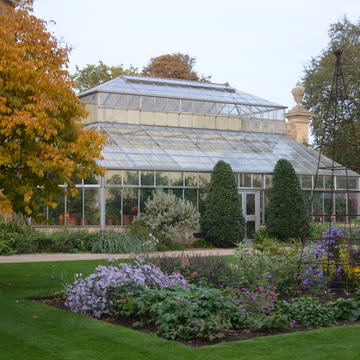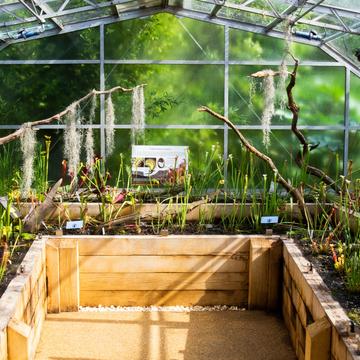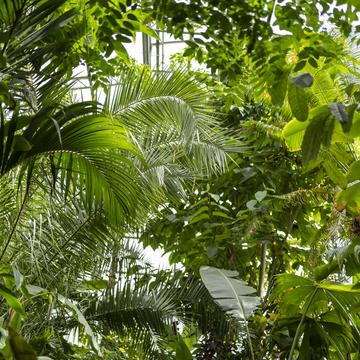The Glasshouses - remake

The Conservatory
Citrus plants have been grown at the Botanic Garden since the 1600s, including lemons, limes, oranges, mandarins, grapefruits and citrons. From late spring, the fragrant scent of the flowers fills the Conservatory. When conditions are right, the plants flower and bear fruit simultaneously throughout much of the year.
As well as being the perfect spot for a picnic, the Conservatory is often used as a venue for our school and family activities. With beautiful seasonal displays and delicious scents, it provides a fabulous backdrop for events such as our Christmas Fairs and Summer Picnics. At Christmas, visiting school children and families decorate our tree using objects such as seed heads collected from the garden.
The Conservatory is a fantastic covered space for private functions, meetings and courses. See our venue hire options for more details.
The Cloud Forest
Our collection of carnivorous Nepenthes pitcher plants grow in this glasshouse. These plants produce an incredible assortment of leafy traps to attract, kill and digest insects. This collection supports the research we do at the Garden in collaboration with scientists in the University’s Department of Biology.
This glasshouse is also home to many different types of fern. Ferns are non-flowering, spore-bearing plants which typically grow in damp habitats. Some species in the glasshouse are epiphytic, such as Platycerium, which grows perched upon the branches of trees. Others, such as Stenochlaena, are terrestrial ferns which produce masses of rhizomes on the soil surface.


The Water Lily House
At the centre of the Garden’s most iconic glasshouse is the tropical water lily pond. It dates from 1851, when it was built to allow the Garden to grow the giant Amazonian waterlily (Victoria amazonica). We now grow the more manageable species Victoria cruziana which is very similar. Also growing in the pond is the beautiful day-blooming Nymphaea x daubenyana. This hybrid water lily was first propagated here in 1874. It was named in honour of Professor Daubeny, Keeper of the Garden from 1834 to 1867.
All the plants growing in the pond show adaptations to their aquatic lifestyle. The water lilies have hollow stems that keep their leaves and flowers afloat. The leaves of the sacred lotus (Nelumbo nucifera) have water-repellent surfaces.
At the margins of the pond is the plant that feeds more people on the planet than any other food – rice (Oryza sativa). There are as many as 120,000 varieties of cultivated rice, providing an annual global harvest of more than 520 million metric tons. Bananas (Musa spp.) can be seen in the jungle-like borders surrounding the pond.
The Carnivorous Plant House
The quiet and calm atmosphere of this house belies the sinister nature of the plants we grow here. In the wild, carnivorous plants grow in nutrient-poor environments where insects provide an essential source of nutrients. Plants have evolved a myriad of different leafy traps to attract, trap and kill unsuspecting insect prey.
Some traps are passive, such as the sticky flypaper of the butterwort (Pinguicula spp.). Trumpet pitcher plants (Sarracenia spp.) have pitfall traps which contain pools of digestive enzymes into which insects tumble and drown. The Venus fly trap (Dionaea muscipula) can move rapidly when triggered by a hapless insect walking across the surface of its jaws. Below ground, bladderworts (Utricularia spp.) have bladder-like traps which ‘suck in’ aquatic invertebrates, via a vacuum.
Many of these species are threatened in the wild because of over-collection for the horticultural trade.


The Rainforest House
In our jungle environment, we grow an assortment of tropical crop plants including cocoa, coffee, rubber, avocado, cinnamon, sugarcane, pineapple, papaya, ginger, cardamom, plantain and vanilla. We also grow important medicinal plants, the rosy periwinkle (Catharanthus roseus), which is used in the treatment of leukaemia, for example.
Competition is fierce in the rainforest, as plants jostle for light and space. With no autumn or winter to halt growth, and a plentiful supply of water, some plants grow at a phenomenal rate. Others have enormous leaves making the most of available light as it filters down through the canopy. Climbers compete with other plants in their search for light, whilst epiphytes perch high up in the canopy on other trees’ branches.
The Arid House
All the plants in the Arid House are adapted to drought. Many take up water rapidly and store it in their succulent stems and leaves during infrequent periods of rainfall. Some of these plants use 'crassulacean acid metabolism' (CAM) – a particularly efficient form of photosynthesis in which their pores (stomata) remain closed during the day to reduce water loss. At night, these pores then open to absorb carbon dioxide.
Rainfall triggers flowering in arid plant communities. Mass flowerings often coincide with the migration of pollinating birds. Other species flower at dusk when pollinating bats emerge, for example cacti such as Cereus uruguayanus which can be seen growing in the Arid House.
The most prominent plants in the Arid House are the giant euphorbia, and next to it, a similar-sized cactus which stand over six metres tall in the centre. These plants evolved on the continents of Africa and North America respectively. Because they both evolved adaptations to survive arid conditions, they look very similar, even though they are unrelated – an example of convergent evolution.






